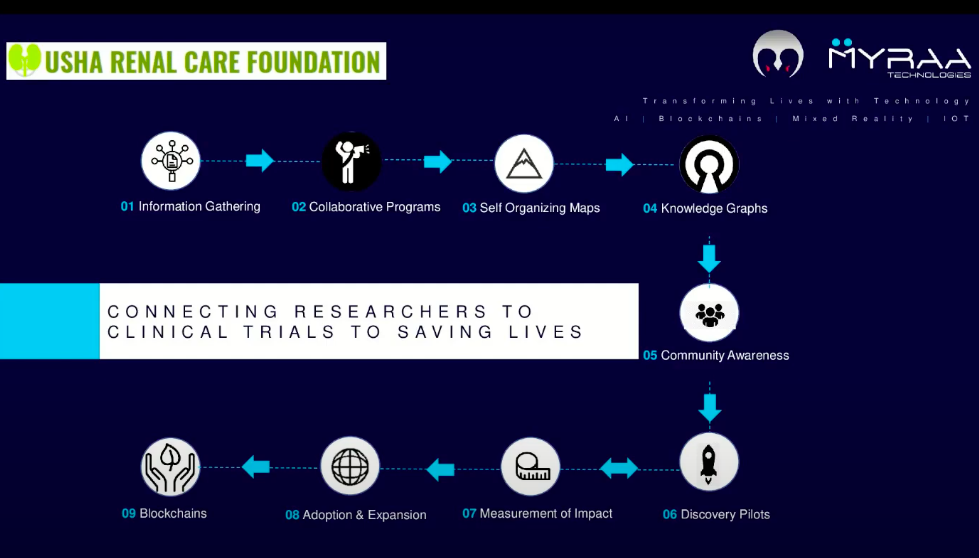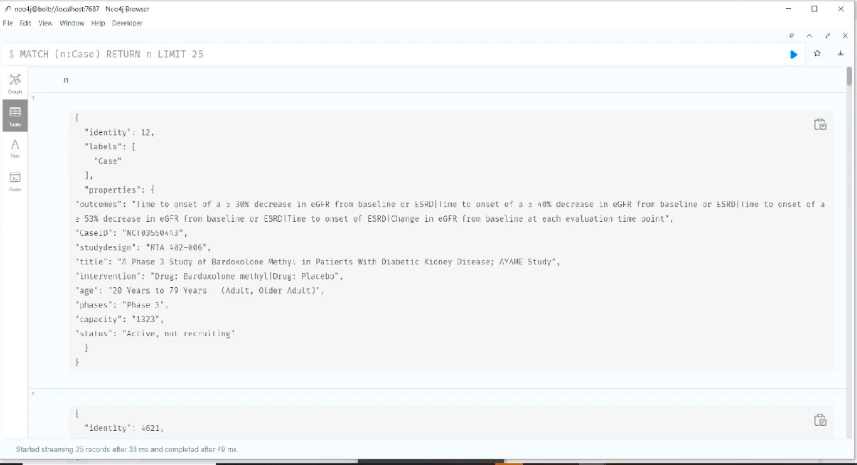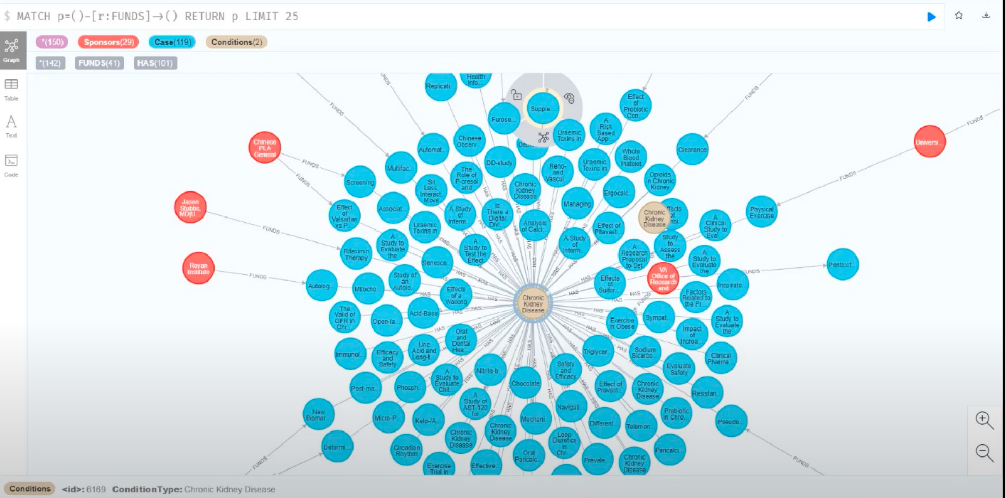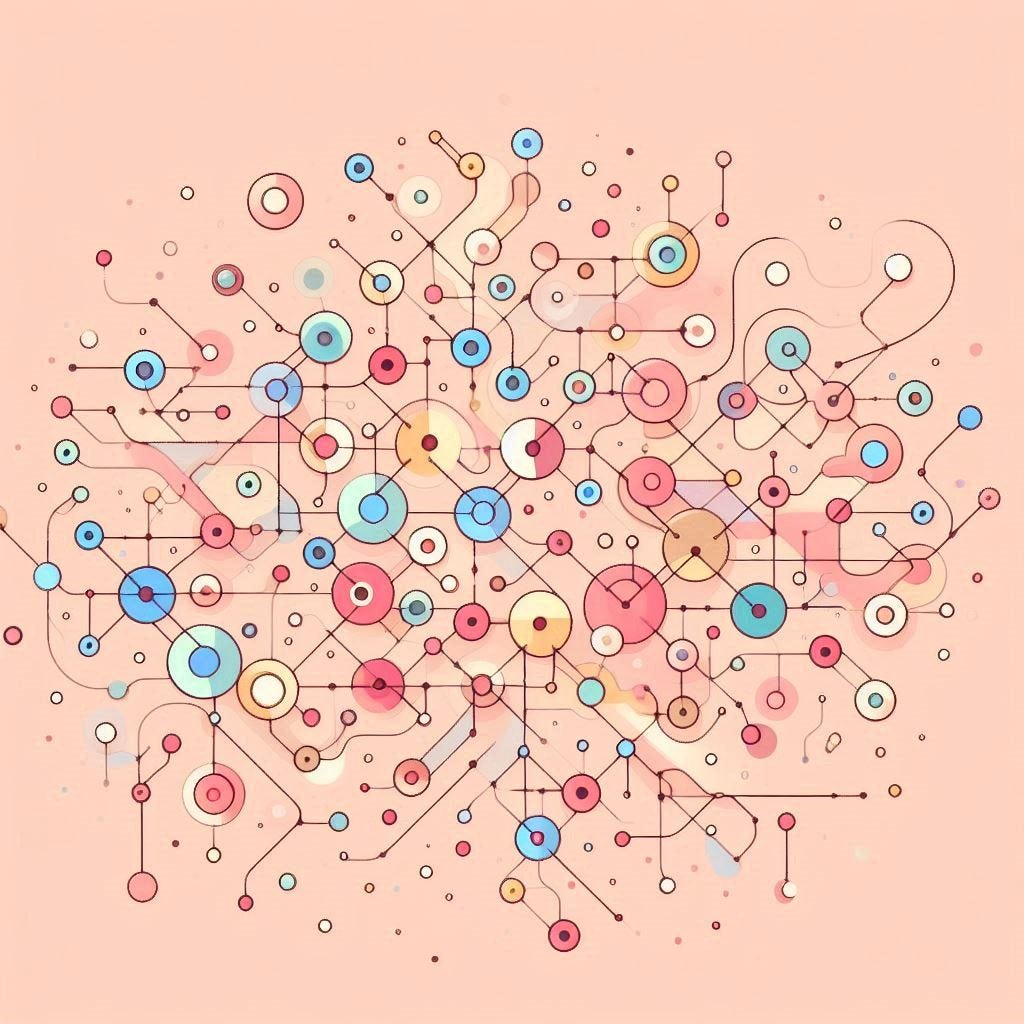Graph That Saves Lives: Connecting Research Papers to Clinical Trials to Saving Human Lives

CEO and Founder, Myraa Technologies
5 min read

Editor’s Note: This presentation was given by Shilpa Karkeraa at Connections: Accelerating Innovation with Graphs.

At Usha Renal Care Foundation, we are collecting information to put in self-organizing maps, in order to have an enriching knowledge repository of data for medical care. This initiative is going to be done in phases, and we’re in the early phases.

Core Problem: Fragmented Data
The core problem that we are looking at is fragmented data in the healthcare industry. When information is fragmented, it becomes difficult to find opportunities for new clinical trials and the patient suffers. This initiative is about connecting the right dots to make the right impact and get the best healthcare facility for the end-patient.
Introducing NephroBlocks
We linked the data together with NephroBlocks. Nephro comes from nephrology, and blocks comes from blockchain data. We are creating a knowledge repository of nephrology data and making it accessible to patients and medical institutions. After speaking with medical experts, a major pain point is the travel of technology from one place to another. When there is advanced technology in one location, it can take a long time, with respect to compliance and awareness, before it reaches another location. That’s why NephroBlocks is here for everybody to get on the same platform and be aware of what clinical trials are happening and their success rates.
Sadly, due to limitations for clinical trials, such as highly specific recruitments and patient profiles, patients don’t know which trials might accept them. In addition, some patients are not in the network of the right nephrologist to even learn of some of the trials in the first place. We’re trying to solve this information sharing problem.
Why We Created NephroBlocks
Neo4j’s graph platform helps expedite finding connections in the data, so the right patient profiles for the right clinical trials can be matched at the right time. In addition, the clinical researchers get to work with each other to find the right cases to match their trial profiles. This is a win-win for everyone.
First, I want to share why we formed the Usha Renal Care Foundation. Why we do this is very personal and close to my heart. This initiative is in the name of my mother, as a tribute to her spirit and 11 years of fighting renal failure. I’m very proud to say that she survived her prognosis beyond what was predicted, and that was due to technology. This was the core inspiration for me to become a technologist and to work day in and day out on this initiative. My mother was a patient for whom technology was leveraged to help her and gave me the childhood I deserved.
I believe that everybody else on earth also deserves that. That’s why I’ve been actively communicating to people about what technologies are out there to save lives. You can search all you want on Google, but not everything is available. When the last stage of my mother’s time came, there was a neuropathy issue where most of the doctors said there was no solution.
The technologist in me could not accept that. There had to be another way, maybe some research or some clinical trial going on somewhere. The feeling of not being able to find a solution led me to create NephroBlocks. Though we’ve started with renal care, this initiative is scalable and we aim to succeed on a larger scale for other areas as well.
Connecting Clinical Trials and Research for Better Patient Discovery
I shared with you my personal journey and motivation, but now I will share how we’ve implemented the graph database and our plans for it.
When I read research papers online and search for the clinical trials that happen in neuropathy, it’s a manual effort to search for answers. Not every person is able to do that at every critical time of their life, which is why building this platform can allow human beings to discover data and connect the dots from research papers to clinical trials to patient profiles, all in one shot.
Today we have more than 50,000 clinical trials related to renal care populated in a database. We have sponsors at organizations which focus on different renal outcomes updating our database continuously using scripts.
When we find common occurrences in the research, then the strength of the relationship in our database increases. Once the data is enriched, then the discovery phase begins.
Graph Discovery Engine
Now I will delve deeper into the technology and how our Discovery Engine works. The Discovery Engine helps us pull out better queries. I can pull patient profiles with diabetes, within the age range of 10 to 25, and with chronic kidney disease. It regroups them based on the clinical trials available at the time. Right now, the focus is for nephrologists to use this data first, but as the system matures, it can give a lot of hope to patients as well. Imagine if a patient is able to have this ray of hope that there is a chance to survive.
The first thing I want to show in the database is data on clinical trial cases.

Where we show the capacity of the trial, you can then ask: Is the trial active or not?
Is it recruiting currently? What are the requirements? What is the age group? What phase is it in?
Next are the cases that we’ve populated.

Then we have the sponsors.

Based on the organization and their locations, we are able to identify their associations, sponsors, and the types of funding they use. This is not just for patients, but also for researchers to identify which organization can help in their research.

We also store conditions in the repository. Selected is Type 2 Diabetes with chronic kidney disease. There are many with these same details. So the first type of relation is the sponsors and the type of conditions we have taken up.

It’s exciting as a patient to see they have these options. When you see the clinical trials in blue, along with the conditions and sponsors, it shows you in one view that these are the initiatives out there.
The Blockchain: The Next Step in Our Journey
The next phase from our Neo4j repository will be to have a blockchain that enables a decentralized network of donation, donors, and donees. We want to do this in a very transparent module, not just for inpatients, but for everybody who wants access to this kind of research.
Conclusion
I encourage you to also take up things that you strongly believe in. With NephroBlocks, we are committed to educate as many people as we can about our graph database and its unified repository by putting all that information on to a decentralized ledger.
Combining Graph Databases and the Blockchain, two forward-looking technology concepts, we can really make a great ecosystem in the healthcare industry. We are committed to making the world safer and more secure and look forward to building and adding value to this community together. Please check out our work and reach out with any questions. Let’s innovate.








